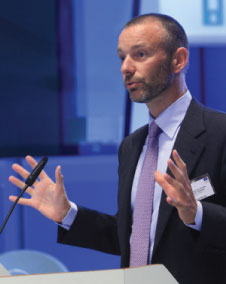By Olivier Jankovec, Director General, ACI EUROPE
 As I write these lines, Eurostat has just released its latest figures showing that the Eurozone has fallen back into recession. At the same time, the EU is engaged in tense negotiations over its budget for the next 7 years – with Member States arguing for cuts and the European Commission pleading for more money to be spent on growth-enabling sectors and projects.
As I write these lines, Eurostat has just released its latest figures showing that the Eurozone has fallen back into recession. At the same time, the EU is engaged in tense negotiations over its budget for the next 7 years – with Member States arguing for cuts and the European Commission pleading for more money to be spent on growth-enabling sectors and projects.
While all these discussions behind closed doors about how much EU money should be earmarked for the Common Agricultural Policy or Nuclear Fission seem very remote from the daily worries of airport managers, they do actually matter for our industry. Indeed, what will be decided by the end of November is also how much EU money will go to the Connecting Europe Facility (CEF), which will provide financing for the EU‘s Trans European Network and the deployment of the SESAR project.
SESAR is the technological and operational component of the Single European Sky. It will bring about a whole range of new technologies and operational processes, allowing for a better integration between air navigation service providers, airlines and airports. As such, it is crucial to our ability to accommodate future demand. SESAR has a strong focus on improving the performance of the European aviation system, with ambitious cost efficiencies and environmental benefits.
But for these gains to materialise, significant investments will be needed from all parties involved – in excess of €30 billion. For Europe’s airports, the bill is expected to reach up to €5 billion by 2030. And this is where the CEF matters, because it will be the only opportunity to get EU financing. Without it, some airports are unlikely to make the necessary investments. Alongside the challenges of current trading conditions, the business case of deploying SESAR may not be obvious for all airports – as related investments will not necessarily bring local benefits given the priority SESAR places on improvements to the network.
For now, European Commissioner responsible for Transport, Siim Kallas is fighting for CEF and he needs full support. This is why ACI EUROPE has asked several prominent European airport CEOs to raise the importance of CEF with their national Governments.
Besides SESAR and CEF, airports in Europe are confronted with a tougher environment when it comes to financing their modernisation and development. This is nothing new, as airports’ capital costs already increased by +23% in 2010 alone, adding a staggering €1.7 billion to our cost base – in spite of much reduced capital expenditure. Unfortunately, there does not seem to be much hope for improvement. This was just recently confirmed by Standard & Poor’s, which noted that lower economic growth prospects do not bode well for the credit rating of European airports.
The risk is of course further reductions in investments. That would cause a disconnect between capital expenditure levels and longer-term demand trends for more and better facilities. But for now, many airports are finding themselves between a rock and a hard place – public financing is retreating while access to private financing remains difficult, if not elusive. This situation is proving especially difficult for regional airports, which are potentially facing a sort of financing cliff – by analogy to a well-known situation across the Atlantic.
Yet, it is puzzling that the revised State aid guidelines on airports being prepared by the European Commission appear to be oblivious to that situation. From what we have been told, the objective is to curb the public financing of airport infrastructure, based on the assumption that there are too many airports in Europe. Hence, the private sector should foot the bill, with airports moving towards full cost recovery and airlines paying for it.
If confirmed, such an approach would clearly stand in the face of the economic reality of airports, negating the essential role they play in Europe’s connectivity and for local development. It would also be at odds with the Trans European Network and the EC’s own Growth & Jobs agenda – not to mention the way in which the new economic powerhouses of Asia or the Gulf are financing their own airport infrastructure.
Ultimately, the challenges of policy making in Europe have a lot to do with alignment. This is something Brian Simpson, Chair of the European Parliament’s Committee on Transport & Tourism, knows very well. In this issue, he shares his views with us on the Airport Package and the other European issues of interest to airports. We also bring you up to speed on the latest developments in external relations, environment and safety – as well as a selection of airport news.







